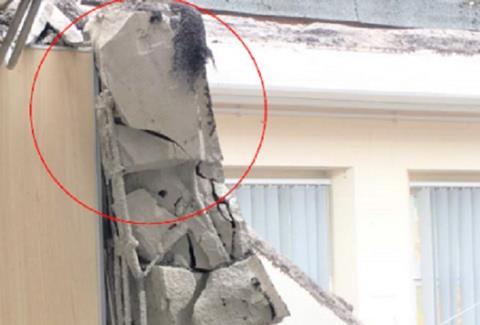One in 10 schools have yet to respond to the department’s surveys - meanwhile DfE publishes list of schools with at risk concrete
The 10% of schools which have yet to return RAAC surveys to the Department for Education are likely to be more widely affected by the problem material, according to a surveyor working on the issue.
Education secretary Gillian Keegan revealed on Monday that nine in 10 of the 15,000 schools sent surveys had provided responses, with 1% having raised concerns about the presence of the lightweight concrete material.

According to James Porter, a partner at Rapleys, which is carrying out RAAC surveys for the London Borough of Hounslow, the 1,500 unreturned surveys could return with a higher proportion of RAAC cases because the types of building where the material is likely to be present are often more complex to survey.
While Victorian-era schools with pitched roofs and new build schools with detailed documentation might find it relatively easy to return a RAAC surveys, others might require a more invasive investigation, particularly if there are complications, such as the presence of asbestos.
“If you’ve got problematic areas that you want to wait for the school holidays to investigate, then you’re not going to return [the survey],” he said.
“Therefore, what you might find is of the ones that haven’t been returned, there could be a higher proportion that do contain RAAC for that reason”.
Earlier this summer, the property consultant had issued its own research which estimated that between 5% and 10% of schools might have used RAAC and the DfE itself has said on its website that it expected hundreds more cases.
>> CLC to set up expert panel to advise on RAAC crisis
>> Comment: We urgently need to invest in our state school buildings. It’s already too late…
>> Comment: Scandal over RAAC school closures points to a deeper malaise
Keegan informed parliament on Monday that the DfE had increased its contracted surveyors from three to eight and that all suspected cases of RAAC would be surveyed “within a matter of weeks”.
According to Porter, the identification process can be “fairly instantaneous” if there is simple access to roof structures via a ceiling tile or access hatch.
But if access is complicated by the presence of asbestos, a quick job costing a few hundred pounds becomes a lengthy four-figure project.
“If one area has asbestos, all of a sudden it’s a little bit more complicated because we need a scaffolding company to come in and put an access tower up, then we need an asbestos removal company to come in and remove the ceiling, then you need to test the air to make sure it is safe for people to come back in and work, then you need a structural engineer to go in and inspect for possible RAAC and then you need a contractor to come in and make good the ceiling,” he said.
Porter said that where RAAC is found, a costly, months-long roof replacement will likely be necessary, but that relatively few buildings will need to be demolished and replaced wholesale “unless the school itself has been earmarked in the short to medium term for wholesale replacement”.
Meanwhile, the DfE has today in England where RAAC has been found and school leaders were told the week beofer the start of term to close buildings or parts of buildings as a precautionary measure. The list shows the start of autumn term has been delayed at 19 schools, while a further four are restricted to fully remote learning.
RAAC Timeline
1950s-1990s: RAAC was widely seen as a wonder material, easily shaped into lightweight, pre-formed components, and was used extensively, particularly for flat roofs.
1990s: Roof collapses related to the use of RAAC begin to be recorded and it becomes understood that the material has a lifespan of roughly 30 years. A large proportion of 1950-era installations were demolished in this period, according to the Standing Committee on Structural Safety.
1996: A government-funded report by the ��ɫ����TV Research Establishment (BRE) found RAAC panels cracking in a housing development and cracks in panels installed in schools.
1999: ��ɫ����TV owners with pre-1980 RAAC were to told by the Standing Committee on Structural Safety (SCOSS) to get them inspected.
2002: A further BRE report adds weight to concerns about the use of RAAC.
2010: Labour’s ��ɫ����TV Schools for the Future programme cancelled by incoming coalition government after a review by then-education secretary Michael Gove.
2014: Conservative-led government launches its schoolbuilding programme
2017: Government launches three-year inspection programme including examination of RAAC in schools.
2018: The ceiling above the staff room of a primary school in Gravesend, Kent, collapses suddenly on a weekend.
May 2019: The Standing Committee on Structural Safety issues an alert to the industry on the back of the Gravesend failure – the committee had also been informed of damage to RAAC roof planks at a retail premises in early 2019
February 2021: The DfE publishes a guide to help responsible bodies identify RAAC
2022: DfE sends questionnaires to all responsible bodies asking them to provide information on the use of RAAC.
September 2022: Surveyors begin to go into schools to look for RAAC and issue ‘critical’ or ‘non-critical’ ratings.
July 2023: Office of Government Property sets up a formal working group in July to coordinate action about potential risks from RAAC across public buildings.
August 2023: Hundreds of schools told to close following unexpected ceiling collapse at a school where RAAC issues had previously been deemed non-critical. Education secretary Keegan later revealed the collapse followed failings at two other properties which had been marked non-critical – one a school and the other a commercial property.
Schools minister Nick Gibb told Sky ��ɫ����TV yesterday that the approach to dealing with RAAC will vary from school to school.
“It will depend on the level of RAAC in the school,” he said. ”What we are clear about is that no child, no member of staff will be in a room that has RAAC.”
The minister also said that he expected the issue in schools would be “sorted out far sooner than Christmas”.
Schools are not the only source of concern, however. Porter warned building owners not to be complacent when it came to RAAC, emphasising that the material was in use outside of the commonly cited 1950s to 1980s period and was not used only in public buildings.
“It is dangerous to sort of pigeonhole into certain ages of construction or types of construction […] it is not just schools and it is not just 50s to 80s,” he said, pointing out that the mistake of focusing on this period had led those surveying court buildings to miss problems at the Harrow Crown Court, built in the 1990s.
“There is no reason the private sector would not have used RAAC too. There is no way of telling who used it and who didn’t so everybody should be keeping an open mind”.
He noted that courts, hospitals and prisons were major areas of concern, but said it would be “foolhardy to pidgeonhole this into one area of buildings”.
The chief inspector of prisons in England and Wales told Times Radio this week that it would be “enormously concerning” if RAAC was found in prison buildings.
“Why this is particularly critical in the case of prisons is that we’re running out of alternatives at the moment to put prisoners anyway,” said Charlie Taylor.
“We have a huge amount of prisoners coming into the system and a limited amount of places … And if this were to become an issue, if Raac were to become an issue within prisons, then it would be enormously concerning.”
What is RAAC exactly?

Reinforced autoclaved aerated concrete (RAAC) is a cementitious material made from fine aggregates. It is factory produced and aerated using a gas then cured by heating. RAAC differs from autoclaved aerated concrete, which is used extensively to produce lightweight blocks with good insulation properties, as it includes steel reinforcement so it can be used for applications requiring better tensile performance. Produced as precast planks, RAAC is mainly used for roof structures although it has been used for walls and floors too.
RAAC has been used since the late 1950’s and was used extensively up to 1980 with some examples dating to as late as 1998. The material was popular because the planks are considerably lighter with much better thermal insulation properties than conventional concrete planks, making it ideal for flat roofs. But the nature of the material means that it has a limited life of 30 years with structural deficiencies becoming apparent in the 1990’s. In 2018 a school flat roof built from RAAC catastrophically collapsed at a weekend, prompting the Local Government Association and Department for Education to contact all school building owners to warn them about the material.
The problem is RAAC is much weaker than conventional concrete with a compressive strength of just 2-5N/mm². It is also very porous which means the reinforcement must be coated to protect it against corrosion. Despite this, the reinforcement can corrode particularly if the roof leaks, leading to spalling. The material is also prone to cracking because of moisture in the concrete and temperature related movement. It is also prone to creep, leading to sagging panels which promotes water ponding on the roof, making leaks more likely and adding extra load on the panels. And RAAC planks can act independently with limited load sharing with neighbouring panels.
As time has gone on our understanding of the potential problems with RAAC has improved. The 2018 school roof failure was thought to have been caused by shear failure close to the place where the panels were supported with the reinforcement stopping short of that support. Manufacturing defects have been found too. RAAC panels rely on transverse reinforcement bars perpendicular to the longitudinal bars; the placing and workmanship of these has been found to be lacking. And there are construction issues too such as cutting the panels to fit onsite, with the risk the transverse bars aren’t over the area of the panel being supported by the wall. Detecting these problems is difficult because intrusive investigation is needed including at the junction between the wall and the panels.
Chris Goodier, the professor of construction engineering and materials at Loughborough University and an expert on RAAC says our understanding of the issues affecting RAAC has grown significantly over the last couple of years and is still improving, leading to the DfE’s decision to close over 100 schools just before the start of term. “Our knowledge of the material has drastically increased over the last few weeks,” Goodier says, suggesting new problems have been identified. According to Nick Gibb, education minister the decision was taken because a beam failed in a school that was previously deemed to have been safe.
Additional reporting by Thomas Lane, group technical editor


























No comments yet